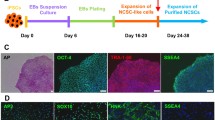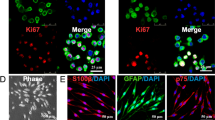Abstract
Vascular network reconstruction plays a pivotal role in the axonal regeneration and nerve function recovery after peripheral nerve injury. Increasing evidence indicates that Schwann cells (SCs) can promote nerve function repair, and the beneficial effects attributed to SCs therapy may exert their therapeutic effects through paracrine mechanisms. Recently, the previous research of our group demonstrated the promising neuroregenerative capacity of Schwann-like cells (SCLCs) derived from differentiated human embryonic stem cell-derived neural stem cells (hESC-NSCs) in vitro. Herein, the effects of SC-like cell conditioned medium (SCLC-CM) on angiogenesis and nerve regeneration were further explored. The assays were performed to show the pro-angiogenic effects of SCLC-CM, such as promoted endothelial cell proliferation, migration and tube formation in vitro. In addition, Sprague–Dawley rats were treated with SCLC-CM after sciatic nerve crush injury, SCLC-CM was conducive for the recovery of sciatic nerve function, which was mainly manifested in the SFI increase, the wet weight ratio of gastrocnemius muscle, as well as the number and thickness of myelin. The SCLC-CM treatment reduced the Evans blue leakage and increased the expression of CD34 microvessels. Furthermore, SCLC-CM upregulated the expressions of p-Akt and p-mTOR in endothelial cells. In conclusion, SCLC-CM promotes angiogenesis and nerve regeneration, it is expected to become a new treatment strategy for peripheral nerve injury.










Similar content being viewed by others
References
Bain JR, Mackinnon SE, Hunter DA (1989) Functional evaluation of complete sciatic, peroneal, and posterior tibial nerve lesions in the rat. Plast Reconstr Surg 83(1):129–138
Brian H, Howard BL, Allan DL (2009) Transplantation of autologous Schwann cells for the repair of segmental peripheral nerve defects. Neurosurg Focus 26(2):E4
Cattin A-L, Burden JJ, Van Emmenis L et al (2015) Macrophage-Induced Blood Vessels Guide Schwann Cell-Mediated Regeneration of Peripheral Nerves. Cell 162(5):1127–1139
Chen P, Piao X, Bonaldo P (2015) Role of macrophages in Wallerian degeneration and axonal regeneration after peripheral nerve injury. Acta Neuropathol 130(5):605–618
Chen J, Zhang X, Liu X et al (2019) Ginsenoside Rg1 promotes cerebral angiogenesis via the PI3K/Akt/mTOR signaling pathway in ischemic mice. Eur J Pharmacol 856:172418
Chen T, Li Y, Ni W et al (2020a) Human neural stem cell-conditioned medium inhibits inflammation in macrophages via sirt-1 signaling pathway in vitro and promotes sciatic nerve injury recovery in rats. Stem Cells Dev 29(16):1084–1095
Chen X, Ye K, Yu J et al (2020b) Regeneration of sciatic nerves by transplanted microvesicles of human neural stem cells derived from embryonic stem cells. Cell Tissue Bank 21(2):233–248
Cho HD, Kim JH, Park K et al (2019) Kochia scoparia seed extract suppresses VEGF-induced angiogenesis via modulating VEGF receptor 2 and PI3K/AKT/mTOR pathways. Pharm Biol 57(1):684–693
Cooney DS, Wimmers EG, Ibrahim Z et al (2016) Mesenchymal stem cells enhance nerve regeneration in a rat sciatic nerve repair and hindlimb transplant model. Sci Rep 6:31306
Cui W, Liu CX, Wang J et al (2019) An oleanolic acid derivative reduces denervation-induced muscle atrophy via activation of CNTF-mediated JAK2/STAT3 signaling pathway. Eur J Pharmacol 861:172612
Dai Y, Hill CE (2018) Transplantation of adult rat Schwann cells into the injured spinal cord. Methods Mol Biol 1739:409–438
Gu SH, Xu WD, Xu L et al (2010) Regenerated host axons form synapses with neurons derived from neural stem cells transplanted into peripheral nerves. J Int Med Res 38(5):1721–1729
Gugliandolo E, D’Amico R, Cordaro M et al (2018) Effect of PEA-OXA on neuropathic pain and functional recovery after sciatic nerve crush. J Neuroinflammation 15(1):264
Guo ZY, Sun X, Xu XL et al (2015) Human umbilical cord mesenchymal stem cells promote peripheral nerve repair via paracrine mechanisms. Neural Regen Res 10(4):651–658
Han HW, Hou YT, Hsu SH (2019) Angiogenic potential of co-spheroids of neural stem cells and endothelial cells in injectable gelatin-based hydrogel. Mater Sci Eng C Mater Biol Appl 99:140–149
Hou B, Ye Z, Ji W et al (2018) Comparison of the effects of BMSC-derived schwann cells and autologous schwann cells on remyelination using a rat sciatic nerve defect model. Int J Biol Sci 14(13):1910–1922
Jain RK, Au P, Tam J et al (2005) Engineering vascularized tissue. Nat Biotechnol 23(7):821–823
Kichenbrand C, Velot E, Menu P et al (2018) Dental pulp stem cell-derived conditioned medium: an attractive alternative for regenerative therapy. Tissue Eng Part B Rev 25(1):78–88
Kingham PJ, Kolar MK, Novikova LN et al (2013) Stimulating the neurotrophic and angiogenic properties of human adipose-derived stem cells enhances nerve repair. Stem Cells Dev 23(7):741–754
Levi AD, Burks SS, Anderson KD et al (2016) The use of autologous schwann cells to supplement sciatic nerve repair with a large gap: first in human experience. Cell Transplant 25(7):1395–1403
Nakamura K, Martin KC, Jackson JK et al (2006) Brain-derived neurotrophic factor activation of TrkB induces vascular endothelial growth factor expression via hypoxia-inducible factor-1α in neuroblastoma cells. Cancer Res 66(8):4249
Naruse K (2019) Schwann cells as crucial players in diabetic neuropathy. Adv Exp Med Biol 1190:345–356
Novosel EC, Kleinhans C, Kluger PJ (2011) Vascularization is the key challenge in tissue engineering. Adv Drug Deliv Rev 63(4):300–311
Okuwa Y, Toriumi T, Nakayama H et al (2018) Transplantation effects of dental pulp-derived cells on peripheral nerve regeneration in crushed sciatic nerve injury. J Oral Sci 60(4):526–535
Pawitan JA (2014) Prospect of stem cell conditioned medium in regenerative medicine. Biomed Res Int 2014:965849
Radtke C, Akiyama Y, Lankford KL et al (2005) Integration of engrafted Schwann cells into injured peripheral nerve: axonal association and nodal formation on regenerated axons. Neurosci lett 387(2):85–89
Ring D (2013) Symptoms and disability after major peripheral nerve injury. Hand Clin 29(3):421–425
Rouwkema J, Khademhosseini A (2016) Vascularization and angiogenesis in tissue engineering: beyond creating static networks. Trends Biotechnol 34(9):733–745
Shi H, Li X, Yang J et al (2019) Bone marrow-derived neural crest precursors improve nerve defect repair partially through secreted trophic factors. Stem Cell Res Ther 10(1):397–397
Stratton JA, Kumar R, Sinha S et al (2017) Purification and characterization of schwann cells from adult human skin and nerve. eNeuro 4(3):ENEURO.0307–0316.2017.
Taylor JSH, Bampton ETW (2004) Factors secreted by Schwann cells stimulate the regeneration of neonatal retinal ganglion cells. J Anat 204(1):25–31
Varejão ASP, Meek MF, Ferreira AJA et al (2001) Functional evaluation of peripheral nerve regeneration in the rat: walking track analysis. J Neurosci Methods 108(1):1–9
Vargel I (2009) Impact of vascularization type on peripheral nerve microstructure. J Reconstr Microsurg 25(4):243–253
Wang H, Zhu H, Guo Q et al (2017) Overlapping mechanisms of peripheral nerve regeneration and angiogenesis following sciatic nerve transection. Front Cell Neurosci 11:323
Wang C, Jia Y, Yang W et al (2018) Silk fibroin enhances peripheral nerve regeneration by improving vascularization within nerve conduits. J Biomed Mater Res A 106(7):2070–2077
Xie S, Lu F, Han J et al (2017) Efficient generation of functional Schwann cells from adipose-derived stem cells in defined conditions. Cell Cycle 16(9):841–851
Yang L, Ge Y, Tang J et al (2015) Schwann Cells transplantation improves Locomotor recovery in rat models with spinal cord injury: a systematic review and meta-analysis. Cell Physiol Biochem 37(6):2171–2182
Ye K, Yu J, Chen T et al (2019) Microvesicles of Schwann-like cells derived from human neural stem cells promote axonal growth of neurons in vitro. J Jiangsu Univ (Med Ed) 29(4):322–326 ((in Chinese))
Zhang Z, Yu B, Gu Y et al (2016) Fibroblast-derived tenascin-C promotes Schwann cell migration through β1-integrin dependent pathway during peripheral nerve regeneration. Glia 64(3):374–385
Zhang L, Gao J, Chen T et al (2019) Microvesicles derived from human embryonic neural stem cells inhibit the apoptosis of HL-1 cardiomyocytes by promoting autophagy and regulating AKT and mTOR via transporting HSP-70. Stem Cells Int 2019:6452684
Zhang L, Ma Y, Wang H et al (2020) Microvesicles secreted by human embryonic stem cell derived mesenchymal stem cells promote regeneration of sprague-dawley rat sciatic nerve. J Biomater Tiss Eng 10(7):966–970
Zhao Y, Wang Y, Gong J et al (2017) Chitosan degradation products facilitate peripheral nerve regeneration by improving macrophage-constructed microenvironments. Biomaterials 134:64–77
Zhao H, Zhang Y, Zhang Y et al (2018) NGF/FAK signal pathway is implicated in angiogenesis after acute cerebral ischemia in rats. Neurosci Lett 672:96–102
Zigdon-Giladi H, Khutaba A, Elimelech R et al (2017) VEGF release from a polymeric nanofiber scaffold for improved angiogenesis. J Biomed Mater Res A 105(10):2712–2721
Acknowledgements
This study was supported by the National Natural Science Foundation of China (Grant No. 81571221), the Science and Technology Cooperation Foundation of Health bioMed (Grant No. 20200605) and the Qing Lan Project of Jiangsu Province.
Author information
Authors and Affiliations
Corresponding author
Ethics declarations
Conflict of interest
The authors declare that there are no conflicts of interest.
Ethical approval
All procedures performed in the studies involving animals were approved by the Animal Ethical Committee of Jiangsu University.
Additional information
Publisher's Note
Springer Nature remains neutral with regard to jurisdictional claims in published maps and institutional affiliations.
Rights and permissions
About this article
Cite this article
Yu, J., Ye, K., Li, J. et al. Schwann-like cell conditioned medium promotes angiogenesis and nerve regeneration. Cell Tissue Bank 23, 101–118 (2022). https://doi.org/10.1007/s10561-021-09920-0
Received:
Accepted:
Published:
Issue Date:
DOI: https://doi.org/10.1007/s10561-021-09920-0




